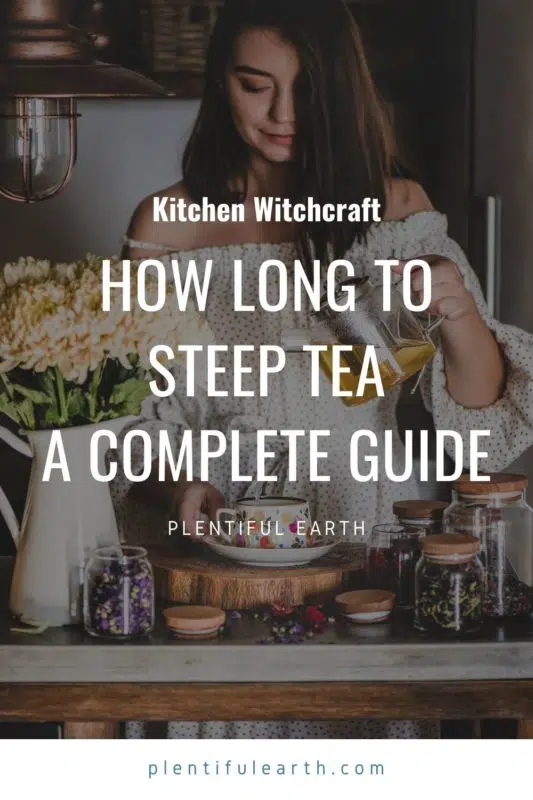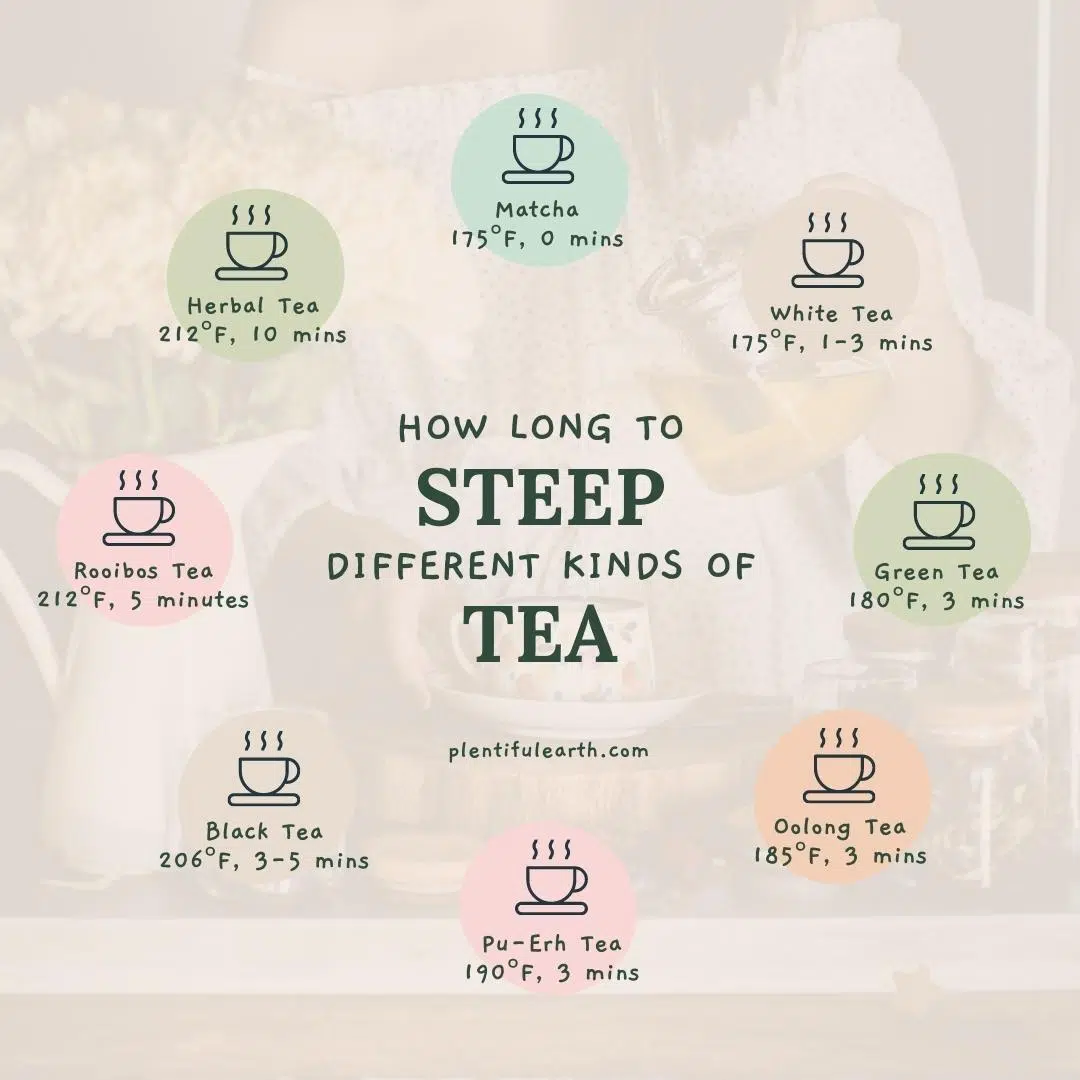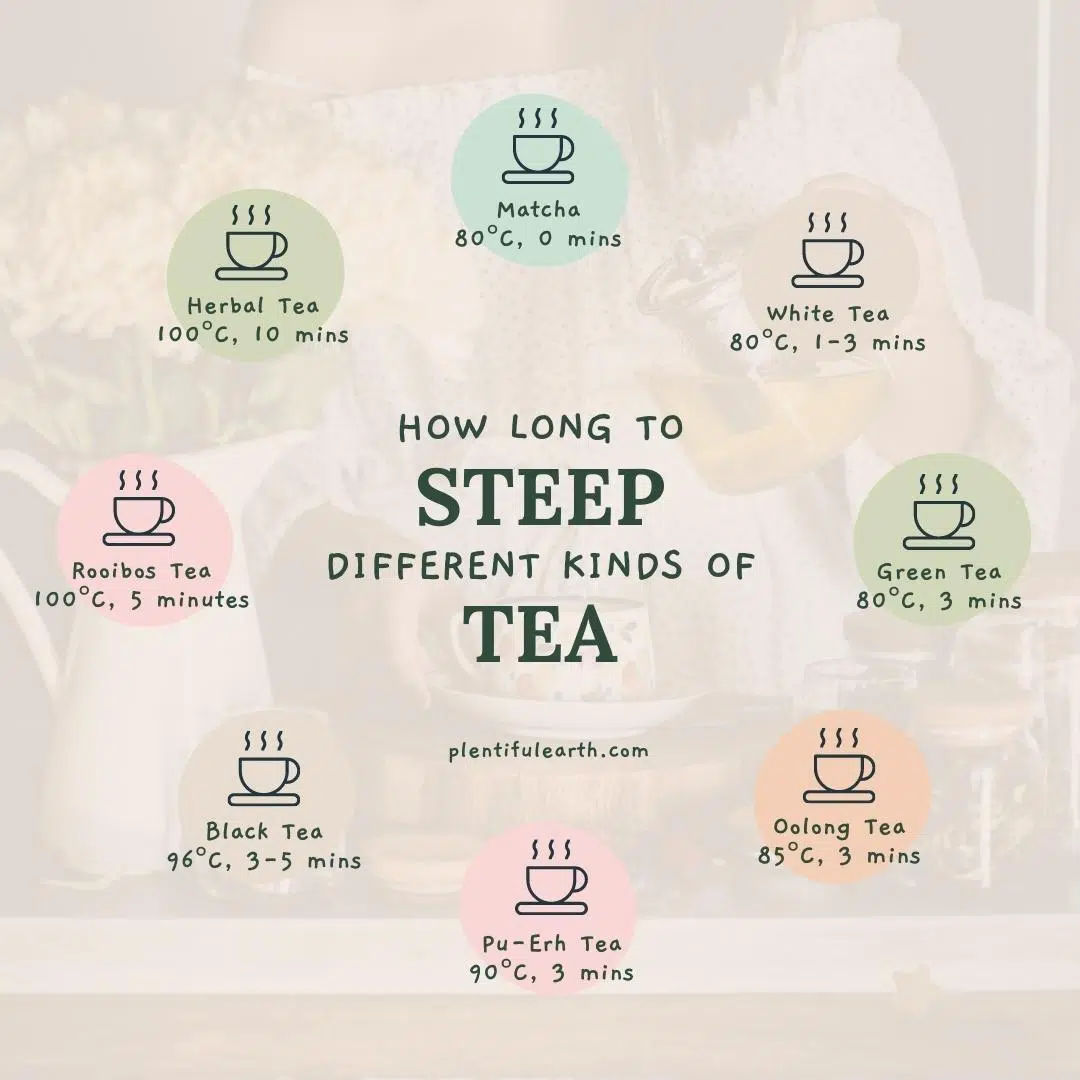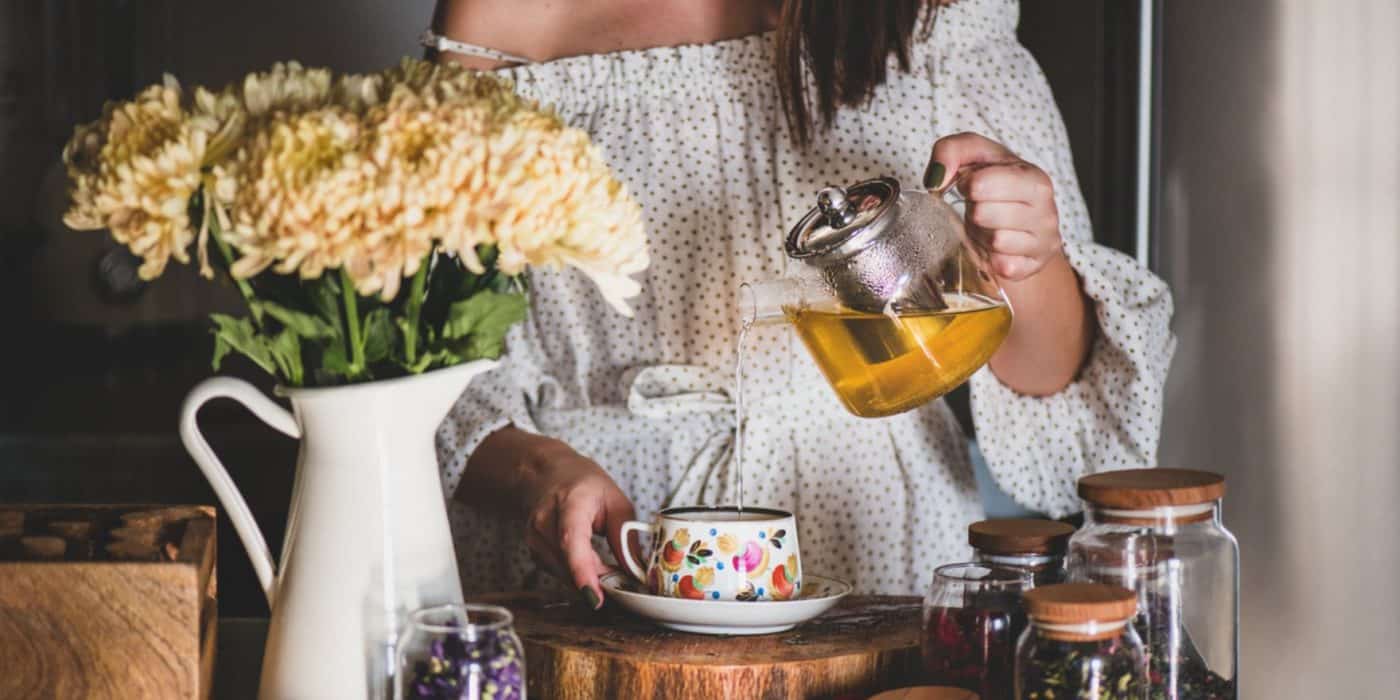Ready to wind down with a nice cup of tea?
Just started enjoying the flavor of tea and want to learn how to make the perfect cup?
Maybe you can’t figure out why tea tastes so bitter and gross?
Tea can be a very polarizing drink if your culture is not steeped in it, so how do you know that you’re making it in the best way possible?
Is there actually a science to making tea taste good?
The answer is – Yes!
And we’ll show you how!
In This Article
- Do Teas Have Different Steeping Times?
- What’s The Difference Between “Regular” Tea & Herbal Tea?
- How Do I Make My Tea Not Taste Bitter?
- Tea Steep Time & Temperature Chart
- How Long Do I Steep Tea Blends That Are Both Herbal & True Tea?
- How Do I Make My Tea Stronger Without Making It Bitter?
- What Should I Steep My Tea In?
- Tea FAQs
Do Teas Have Different Steeping Times?
Yes.
Different teas have different steeping times due to the:
- Type of tea you’re brewing – true leaf or herbal.
- Thickness of the leaf or herb – leaf, fruit, stem, or root.
- Maturity of the leaf – young white or mature black.
- Preparation style of the leaf – rolled, cut, pearled, sifted.
- Freshness of the leaf or herb – dried or fresh.
- Required temperature of hot water to bring out the best flavor profile – cool, warm, or hot water.
In general, if your tea tastes bitter you may have steeped it for too long.
A good rule of thumb to follow is that true tea leaf teas take up to 4 minutes, while some herbal tea infusions typically take up to 10 minutes to steep.
What’s The Difference Between “Regular” Tea & Herbal Tea?
What Are “Regular” True Teas?
Regular teas or “True Teas” are made from tea leaves that come from the tea plant.
These are your black tea, oolong tea, green tea, white tea, and pu-erh tea.
Each type of true leaf tea has been picked at different stages of growth and cured, dried, or fermented for different lengths of time.
These different ages of tea and drying methods contribute to new taste profiles and different levels of medicinal benefits.
Because true tea leaves contain tannins, steeping them for too long or at the wrong temperature can lead to bitter-tasting tea.
Wondering about caffeine?
True teas contain caffeine unless they have gone through a decaffeination process.
What Are Herbal Teas?
Herbal teas, on the other hand, are created by adding various fruits or herbs, such as peppermint, cinnamon, or dried fruit pieces.
Because these are not made from tea leaves, they often do not contain caffeine or have a very low caffeine content.
Caffeine content depends on what herbs are included in your tea.
With herbal teas, each different herb or fruit has different health benefits.
For instance:
- Peppermint tea helps relax sore throats, calm stomach aches, and improve your mood.
- Ginger tea helps relax muscle tone, reduce cramping, and aid in digestion.
- Lemon tea contains natural amounts of vitamin C to help boost your immune system.
- Chamomile tea helps relax your nervous system and pull you out of fight-or-flight mode.
Each ingredient of an herbal tea blend has different benefits, but in general, steeping herbal teas for 10 minutes helps make sure that each healthy compound is transferred into your tea.
Since most herbal teas do not contain the tannin found in true tea leaves, you can safely steep them for up to 10 minutes or simmer them longer as a decoction without getting a bitter taste.
How Do I Make My Tea Not Taste Bitter?
If your tea tastes bitter, you may be steeping it for too long or your water temperature may be too hot.
Bitter tea happens when too many tannins are released from true tea leaves.
All you have to do is follow the tea steeping guide below to get rid of bitter tea.

Tea Steep Time & Temperature Chart
Ready to brew the perfect cup of tea?
Water temperature and steep times differ for different tea types.
In general, if the tea leaf is younger, cooler water should be used.
The guide below lists the perfect temperature to brew tea at, plus the amount of time to let your tea mixture steep.
Teas are listed in order of steep time, so faster teas are first on the list!
Tea Steep Time Chart – Fahrenheit

Matcha Tea: 175°F | 0 minutes
White Tea: 175°F | 1-3 minutes
Green Tea: 180°F | 3 minutes
Oolong Tea: 185°F | 3 minutes
Pu-Erh Tea: 190°F | 3 minutes
Black Tea: 206°F | 3-5 minutes
Rooibos Tea: 212 °F | 5 minutes
Herbal Tea: 212°F | 10 minutes
Tea Steep Time Chart – Celsius

Matcha Tea: 80°C | 0 minutes
White Tea: 80°C | 1-3 minutes
Green Tea: 80°C | 3 minutes
Oolong Tea: 85°C | 3 minutes
Pu-Erh Tea: 90°C | 3 minutes
Black Tea: 96°C | 3-5 minutes
Rooibos Tea: 100°C | 5 minutes
Herbal Tea: 100°C | 10 minutes
Note that only herbal tea and rooibos tea use boiling water.
How Long Do I Steep Tea Blends That Are Both Herbal & True Tea?
If you have a mixed tea blend that contains tea leaves and dried herbs, steep your tea blend according to the true tea leave that are in it.
For example, if your tea contains dried pineapple, coconut, and green tea leaves, steep the tea for 3 minutes.
From here, you can decide if you’d like to experiment with a longer steeping time. Sometimes, the sweetness from the herbal components masks the bitter flavors of the true tea.
How Do I Make My Tea Stronger Without Making It Bitter?
Increasing the strength of your tea depends on the type of tea you’re making.
True Leaf Tea – Black, Oolong, Green, White & Pu-Erh
Want true leaf tea to have a stronger flavor? Add more tea leaves!
We know, it seems counter-intuitive to not just steep it longer, but long steep times mean a more bitter flavor profile.
Why?
Because longer steeping times cause more tannins to steep out of your leaves and into your tea water.
So, you’ll want to keep the steeping time the same and add more tea leaves to add more flavor.
Herbal Teas
If you’re making herbal infusions, you can either add more of the herbal blend or let it brew for longer!
Try both and pick your preference! We prefer adding more tea.
What Should I Steep My Tea In?
This depends on your personal preference and amount of tea that you are making.
The Witches here at Plentiful Earth like to make individual servings that have intentions set into them. So, they like to use a tea ball strainer or reusable tea bags and steep their tea in enchanted teapots.
Yes, teas have spiritual vibes!
If you’re making tea for a crowd, it may make sense to steep your tea in a heat-proof pitcher or large tea kettle.
Making tea for yourself? Heat your water in your favorite tea kettle (we like this one), and pour it over tea leaves in your mug.
You can use reuasble tea bags or tea balls to brew your loose leaf teas.
Tea FAQs
Check Out Our Magical Tea Kitchenware
Try These Tea Recipes & Potions
- 4 Iced Potions that will Literally Change Your Life
- Love Potion #13: Iced Hibiscus Cinnamon Tea Potion Magickal Recipe
- Money Maker: Spiced Mint Iced Tea Potion Recipe
- Focus Pocus Iced Lemonade Magickal Potion | A Kitchen Witch Spell Recipe
- Best of the Stress: Iced Earl Grey Lavender Tea Potion Recipe
You may also like:



